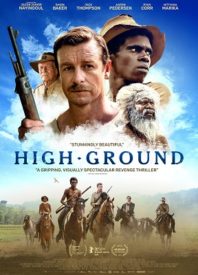
Whiteness exists as complex yet menacing presence in TSephen Johnson’s High Ground even when white settlers are not on screen. Its first of four acts begins with an act of violence that white settlers commit without mercy. That’s especially true for the ones in Australia, ruining the beautiful landscape with the blood they spill. The film depicts them killing families of Yolgnu and Biminj origin. Grandfather Dharrpa (Witiyana Marika) survived because he was away when the massacre happened. The act, taking place during the 1910s, does have repercussions. One of the other survivors is Baywara. He survives the attack and spends the rest of his life avenging his family by killing.
High Ground makes Baywara’s vengeance as a catalyst for two other people involved in the attack. His vengeance continues for two decades, long enough for white authorities to stop tolerating him and arrest him for themselves. A Crown official, Moran (Jack Thompson), assigns two unconventional teams to arrest or kill Baywara. But it focuses on one of those duos. The first member of that duo is Travis (Simon Baker), a white sniper who served during the First World War. That survivor is Gwijuk (Jacob Junior Nayinggul), who has no one but a priest (Ryan Corr) to raise him. Travis treats Gwijuk like a nephew, giving him tough love and wisdom. But Gwijuk’s allegiances change as he discovers Baywara’s motivations and Travis’ complicity in the original attack.
Viewers might never know the specifics within High Ground‘s intentions. This is especially true since the relationship between Indigenous and white settlers in the film are volatiles. We can say the same about relations between white people and all people of color today. I’m giving this the benefit of the doubt. The same goes for positioning Travis as a white ally among his fellow racist whites. It’s obvious that its depiction of white fragile masculinity is a critique of it. Other characters archetypes here include a straight up racist and a boy scout. Although it’s surprising to see Moran believe in some race mixing. He praises a ‘half-caste’ (Aaron Pedersen) as a law official. Either way, the stereotypes here are broad, and I’d rather see more Indigenous scenes.
Yes, the depiction of archetypes can be a subject of nitpicks. And even the most violent meat pie Westerns have middle scenes that feel like filler. But at its core, High Ground is a study of people. Again, it starts out by showing the Northern Territory’s landscapes in juxtaposition with human suffering. But as the film progresses, it becomes close-up heavy. It gives viewers little choice but to confront its viewers with its characters. We know Simon Baker from his work in Hollywood but he recently lent his talent to fleshing out Australian stories. And there’s something humbling about his involvement here and he and a cast of white and Indigenous Australians work well.
- Release Date: 5/14/2021

